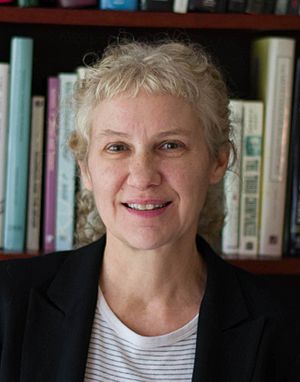Nancy Bonini facts for kids
Quick facts for kids
Nancy M. Bonini
|
|
|---|---|
 |
|
| Born | 1959 (age 65–66) |
| Nationality | American |
| Alma mater | Princeton University (AB) University of Wisconsin-Madison (PhD) |
| Known for | Developed the first Drosophila model of human neurodenerative disease |
| Spouse(s) | Anthony Cashmore |
| Awards |
|
| Scientific career | |
| Fields | |
| Institutions | University of Pennsylvania |
| Doctoral advisor | David L. Nelson |
Nancy M. Bonini (born 1959) is an American neuroscientist and geneticist. She is famous for being the first to use tiny fruit flies, called Drosophila, to study serious human brain diseases. These diseases, like ALS (also known as Lou Gehrig's Disease), Alzheimer's disease, and Parkinson's disease, affect how our brains work.
Dr. Bonini's research team uses fruit flies to find out which genes and processes in the body are important for these brain diseases. They also study how aging, brain injuries, and even poisons from the environment can affect the brain.
Since 1994, Dr. Bonini has been a professor of biology at the University of Pennsylvania. She has held several important positions there, including the Florence RC Murray Professor of Biology. She was also the editor of a science magazine called Annual Review of Genetics from 2018 to 2021.
Contents
Early Life and Education
Nancy Bonini was born in 1959. Her father, William “Bill” Bonini, was a professor at Princeton University. Nancy, her sister Jennifer, and her brothers Jack and Jamie all went to Princeton University, just like their dad.
Nancy Bonini earned her first degree, an AB in Biology, from Princeton University in 1981. Her first scientific paper was based on her college research about how fruit flies learn.
After Princeton, she went to the University of Wisconsin–Madison. There, she earned her Ph.D. in Neuroscience in 1987. She then did more research at the California Institute of Technology. It was during this time that she made a big discovery: she showed that fruit flies could be used to understand human brain diseases.
Understanding Brain Diseases with Fruit Flies
Why Fruit Flies Help Us Study the Brain
In 1998, Dr. Bonini's research proved that Drosophila (fruit flies) could be used to study human brain diseases. This was a huge step! Using these tiny flies, her team found new ways that diseases affect the brain.
In their first big study, they worked with other scientists to look at how certain human proteins linked to brain diseases acted in fruit flies. They found that flies with the "mutant" (changed) version of the protein showed signs similar to human patients. Flies with the normal protein did not. This showed that fruit flies could be a good "model" to understand these diseases.
How Special Proteins Help Fight Brain Diseases
Dr. Bonini's team studied a group of brain diseases called "polyQ diseases" using their fruit fly models. They found that special proteins called molecular chaperones play a key role. Think of chaperones like helpful guides that make sure other proteins in your body fold correctly.
They discovered that if they increased the amount of a chaperone called Hsp70, it helped protect the brain cells in the flies. This finding suggested that chaperones could be a new way to treat diseases like Parkinson's disease. They even showed that a medicine called geldanamycin, which helps chaperones, could stop brain problems in flies if given early. This gives hope for new treatments for people.
Studying ALS (Lou Gehrig's Disease)
Dr. Bonini's lab also created a fruit fly model for ALS, also known as Lou Gehrig's Disease. This disease affects nerve cells in the brain and spinal cord, leading to muscle weakness.
Using their fly model, her team found a gene called ATXN2 that makes people more likely to get ALS. They also found that stopping a certain interaction in the body could be a good way to treat ALS and similar diseases.
Tiny Molecules That Protect Your Brain
The Bonini lab found that a tiny molecule called miR-34 helps protect the brains of aging fruit flies. When flies lost miR-34, their brains aged faster, and they didn't live as long. But when they had more miR-34, they lived longer and their brains stayed healthier. This suggests miR-34 might be important for protecting our brains as we get older too.
New Ideas About Alzheimer's Disease
In 2018, Dr. Bonini and her colleagues studied brain samples from people with and without Alzheimer's disease. Alzheimer's is a disease that causes memory loss and thinking problems, usually in older people.
Their study showed a new link between aging and Alzheimer's disease. They found that certain normal changes that happen in our bodies as we age actually protect us from Alzheimer's. If these protective changes are messed up, it might make someone more likely to get the disease. This new idea could change how scientists think about and treat Alzheimer's.
Awards and Honors
Dr. Nancy Bonini has received many important awards for her amazing work:
- She was an Investigator for the Howard Hughes Medical Institute from 2000 to 2013.
- In 2012, she was chosen to be a member of the National Academy of Sciences and the National Academy of Medicine. These are very high honors for scientists in the United States.
- She was also elected a Fellow of the American Association for the Advancement of Science in 2012.
- In 2014, she became a member of the American Academy of Arts and Sciences.
She has also received special awards like the March of Dimes Basil O'Connor Award (1996), a Packard Fellowship for Science and Engineering (1997), and a National Institutes of Health Outstanding Investigator R35 Award (2016). In 2010, she even appeared on the TV show Charlie Rose to talk about the brain!
Personal Life
Dr. Bonini is married to Anthony Cashmore. He is also a professor at the University of Pennsylvania. He is known for discovering a special protein in plants that helps them sense blue light.
Images for kids



